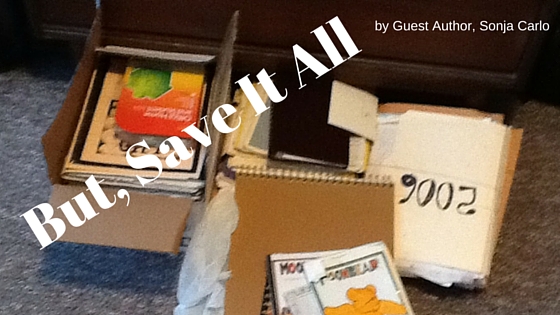A big, hearty welcome to my good friend, Sonja Carlo, who provided this guest post. Please visit her website at Brown Rabbit Books.com
Too many boxes of papers and notebooks
I was downsizing a few years back and hunted for room to stash my ever-growing stack of journals which at that time comprised several good-sized boxes. Boxes full of my writing since 1973, a few of the years from 1973-1988 were already in a 3 ring binder that I had made before I left Alaska but the majority were not and in fact I had to spend a day sorting them all out in yearly piles in my living room, like dealing a deck of cards. Many of the entries, pages and poems had duplicates; hundreds of pages and entries that I had copied several times to get edited poems for poetry contests which I used to enter in the 1990’s. A lot of my muse comes out as poetry material. I ended up burning stacks and more stacks of duplicate copies and useless notes and scraps in my driveway that summer. I ended up with several beautiful 3 ring binders of the years of journaling lined up in a special shelf I bought for that purpose.
Problem of too many notebooks
They stayed that way for several more years also moved about and investigated a bit. Finally I had to come to terms with the problem as it took shape. I knew I needed to sort again to downsize the stacks of journals.
Problem of notebooks: a mess of unorganized papers.
About 2011 I began to realize I was not getting any younger and if I wanted to downsize to perhaps move, I had better get down to business, and do something about those journals. I collected the years 1973-1989 and scanned, edited, cleaned most of the copies and stuck in some pictures taken in Alaska and had it all bound at a local office store that does such things. I loved the finished product and was encouraged and anxious to get on with the rest of the years. 1990 took a longer time to complete and I did not get it done until the following year. I had written a lot in 1990 and other life events put it on the back burner. Never the less it reached the binder too, and I was again thrilled. I surprised myself with the accomplishment and was spurred on to the next one. This collection of 1991 to 1994 took only a few weeks; there were less bad soiled copies, and a deadline, as I hurried to get it done before my trip to California to see my daughter.
If you have old copies of stuff you wrote, letters, cards, autographs, awards, scrapbook stuff saved in boxes, you can do the same thing because my boxes had all that stuff in them, including some school papers written when I decided to go back to college.
Problem of paper vs computer solved
During all of this collecting, stashing, storing, sorting, and burning, I realized I was using that my computer more and more to write. A down side of that was that I was using 5-subject college lined notebook of choice to write in every year and had a growing problem of transferring it to Microsoft word. It was a chore for me at times when doing so.

After retiring in 2009 I discovered self-publishing sites and published 3 years of my journal entries in a book about being an AIDS caregiver. Still, transcribing from paper to Microsoft word, I was slowly mixing paper and computer entries; that helped but did not solve the problem until last winter when I was sick and spent a lot of time meditating on my couch in the morning and throughout the day. I started to interrupt prayers and or meditation or TV shows to type my thoughts into a notes program on my iPad. Problem solved! Now it’s my iPad notes that comprise the majority of my journal writing outside of my purse journal which I carry with me everywhere.
Expensive binding problem solved
Looking at the problem of paper stacks from 1995 to 2009 and I now hope to scan them all to Microsoft this winter avoiding the expensive bound copies at the office stores. In conclusion, I advise
when in doubt, save it all!
************************
You can find Sonja’s books on Amazon. Many come straight from her journals. Check them out!
- The Christmas Maker: Santa’s First Flight
- The Willow Whistle: A Camping Craft, Easy and Inexpensive
- Paper Tongues Whisper: Poems for the Unborn
- October in My Soul: Conversion and the Comforter
- The Flawless Gift: A Story about Friendship and Old-Fashioned Morals
- Something Lovingly Planned: HIV Caregiver Journal




